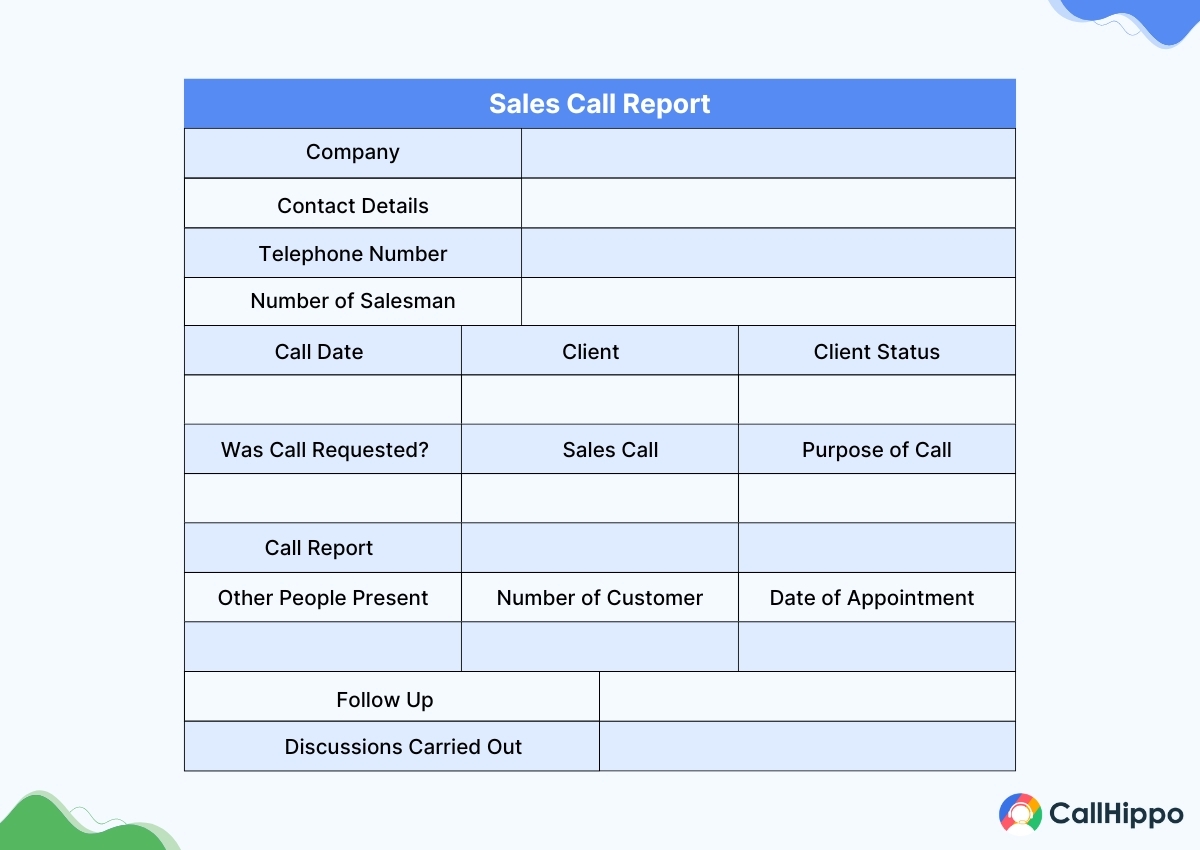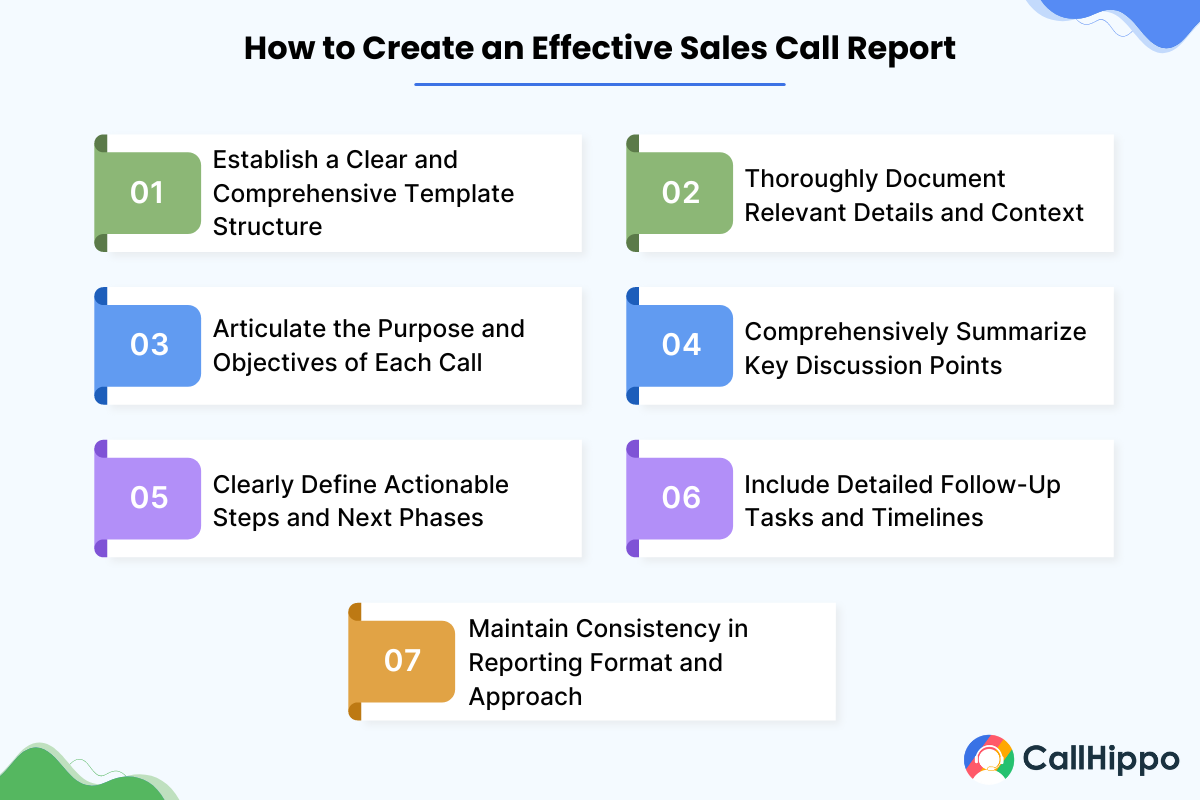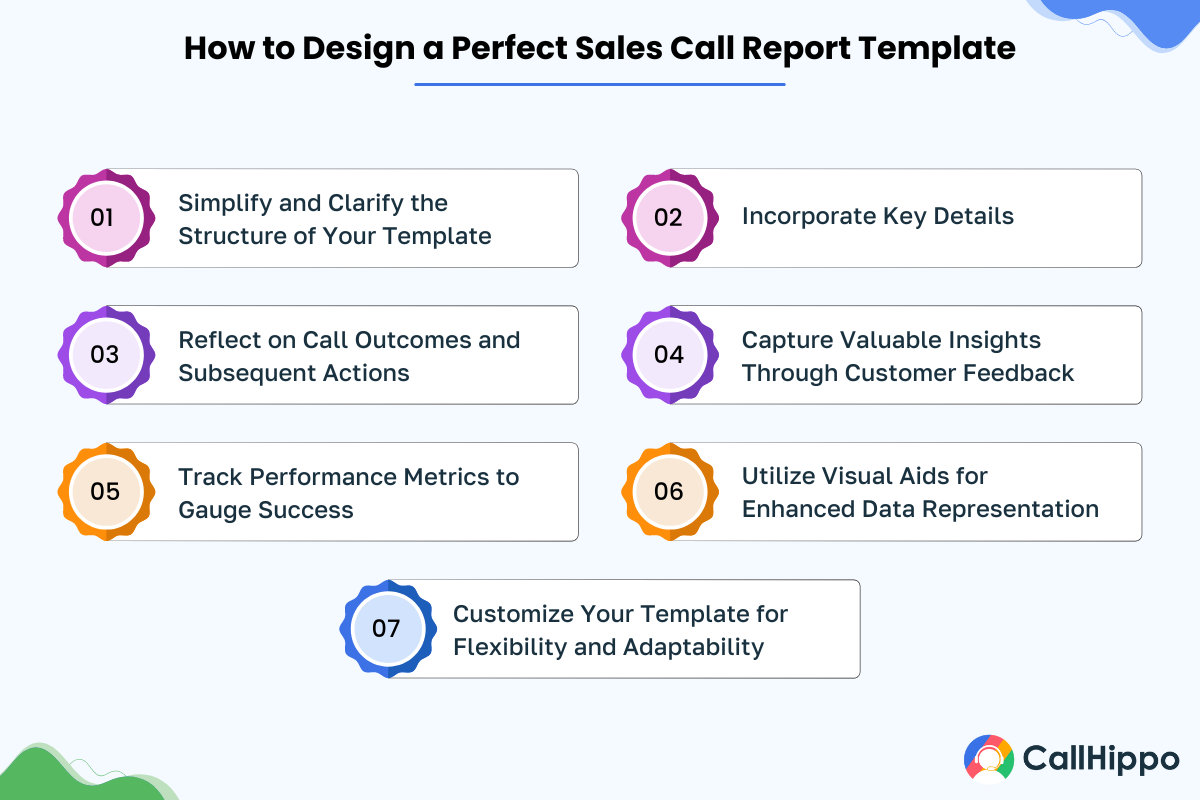

Keeping track of your sales calls is crucial for understanding your progress, identifying areas for improvement, and ultimately amplifying your sales. One such element that helps you with this is– sales call reporting.
In this blog, we will discuss all the key aspects of sales call reporting, covering its definitions, things to include in sales reports, and the best practices for creating a sales call report format. Later in the blog, we will also provide you with some ready-to-use sales call report templates.
Let’s get started.
Always review your sales call report before taking any action. Look for patterns in customer feedback, identify areas for improvement, and celebrate successes.
Use the data to refine your sales approach, tailor your pitches to customer needs, and strengthen relationships.
Sales call reporting involves documenting details about each sales call, such as who was contacted, what was discussed, and any next steps planned.

The sales call report format typically includes information like the date and time of the call, the customer’s name and contact information, the purpose of the call, outcomes, and any follow-up actions required. This data helps sales managers understand sales performance, identify trends, and make informed decisions to improve strategies.
By regularly documenting these interactions, businesses can analyze their sales efforts, improve customer relationships, and make informed decisions to enhance sales strategies.
Even though there are different sales call reporting formats based on use cases, a typical sales call report includes details such as contact information, call purpose, key discussion points, action items, and so on. Let’s take a closer look at each of these elements.
Begin with basic details like the name and contact information of the person you spoke with. This helps in keeping records organized and easily accessible for future reference. Include the date and time of the call, too.
Next, clearly state the purpose of the call. Whether it was for introducing a new product, addressing a customer issue, or following up on a previous conversation, this information provides context for understanding the outcome.
Summarize the main topics covered during the call. Highlight important points such as customer pain points, interests, objections, or any specific requirements they mentioned. This helps in understanding the customer’s needs and tailoring future interactions accordingly.
Note down any action items agreed upon during the call. This could include sending additional information, scheduling follow-up meetings, or resolving customer issues. Assign responsibilities to specific team members and set deadlines to ensure accountability.
Outline the next steps to be taken after the call. Whether it’s scheduling another meeting, sending a sales proposal, or conducting a product demonstration, clarity on the next course of action is essential for moving the sales process forward.
Identify any potential sales opportunities that emerged during the call. This could be expressed interest in a product or service, willingness to explore new solutions or indications of a buying decision in the near future. Highlighting these opportunities helps in prioritizing leads and allocating resources effectively.
Document any challenges or obstacles encountered during the call. This could include objections raised by the prospect, concerns about pricing or competition, or any other barriers to closing the deal. Understanding these challenges enables the sales team to develop strategies for overcoming them in future interactions.
By including these key elements in your sales call reports, you can ensure comprehensive documentation of interactions with customers, facilitate collaboration within the sales team, and ultimately drive better results in closing deals and building strong customer relationships.
Whether you’re a seasoned sales professional or just starting out, having a well-organized and comprehensive sales call report can make a significant difference in your success. Here are some tips to help you create an effective sales call report:

Begin by setting up a structured format for your sales call report, encompassing essential sections such as contact details, date, purpose, discussion points, action items, and follow-up tasks. This standardized layout will simplify the reporting process and facilitate efficient analysis of your sales activities.
Capture all key information during your sales calls, including the name, title, and company of the individual you engaged with, along with their contact particulars. Ensuring comprehensive documentation of contextual details will provide valuable insights and ensure smoother movement through the sales pipeline.
Clearly articulate the primary objectives and intended outcomes of every sales interaction within your report. Whether it’s an introductory conversation, a follow-up inquiry, or a decisive closing attempt, outlining the purpose ensures alignment with overarching sales strategies and enables effective progress tracking.
Thoroughly summarize the main discussion topics and significant insights gleaned during the call. This detailed summary should encompass inquiries posed, objections raised, agreements reached, and any other pivotal aspects shaping the sales dialogue. A comprehensive overview ensures clarity and enhances subsequent decision-making processes.
Whether it involves scheduling follow-up meetings or providing further clarification, articulating these next steps within the report ensures seamless execution and builds sustained momentum in the sales process.
These tasks may include sending follow-up correspondence, updating CRM records, or scheduling next engagements. Establishing clear follow-up procedures ensures diligent follow-through and cultivates long-lasting client relationships.
Uphold consistency in both the format and approach utilized for generating sales call reports. Adhering to a standardized reporting framework builds coherence and ensures seamless comparison and analysis of sales activities over time. Consistent reporting practices enhance accuracy and drive sales.
By following these tips and consistently creating detailed and accurate sales call reports, you’ll be better equipped to track your progress, identify areas for improvement, and ultimately close more deals.
The following form is an example of a well-designed sales call report template. It illustrates how to add and structure essential details, incorporate visual elements, and customize for various sales scenarios effectively.
Date: [15-05-2024] Customer Information:
Objective of the Call:
Discussion Points:
Action Items:
Challenges Faced:
Follow-up Plan:
Sales Opportunities Identified:
Additional Notes: ____________________________________________________________________________________________________________________
As you can see, this sales call report form is a simple tool for tracking your conversations with customers. It helps you jot down important details like the date, who you talked to, and what you talked about.
You can tick off boxes to note down the purpose of the call, what you discussed, any challenges you faced, and what you plan to do next. Lastly, there’s space for extra notes if you need it.
Moreover, you can create an Excel spreadsheet to summarize your sales call reports efficiently. This summary sheet consolidates key information from all your calls into one convenient place. Here’s an example table illustrating how your summary report could look:
| Date | Salesperson | Customer | Purpose | Duration | Method | Attendees |
|---|---|---|---|---|---|---|
| 2024-05-10 | John Smith |
Moreover, you can create an Excel spreadsheet to summarize your sales call reports efficiently. This summary sheet consolidates key information from all your calls into one convenient place. Here’s an example table illustrating how your summary report could look:
| Date | Salesperson | Total Calls | Meetings Scheduled | Deals Closed |
|---|---|---|---|---|
| 2024-05-01 | John Smith |
This summary provides a quick overview of each salesperson’s performance, including the total number of calls made, meetings scheduled, and deals closed.
Now, let’s explore a few sales call report examples tailored to your sales team. Remember, while these templates provide a solid foundation, feel free to customize them to fit your specific requirements or even create one entirely from scratch.
This one-pager sales call planning and report template offers a concise yet comprehensive tool for organizing your sales calls. It helps you plan your approach before the call and record key details afterward. Easy to use and understand, this template streamlines your sales process, ensuring nothing falls through the cracks while keeping everything on a single page.
This summary sheet tracks sales calls made by individual agents. It provides a clear overview of each agent’s performance, including the number of calls, meetings scheduled, and deals closed. By using this sheet, managers can easily identify top performers and areas for improvement, ultimately enhancing the effectiveness of the sales team.
This single-page Sales Call Follow-up Template simplifies post-call tracking. Easily note call details, outcomes, and action items. It’s user-friendly and efficient, ensuring all essential information is captured for effective follow-up. Customize it to suit your team’s needs for seamless sales communication and progress monitoring.
So, these were the three sales call report examples. However, note that you can customize them according to your requirements or design your own from scratch.
The ultimate goal should be to have a sales call reporting form that helps you better manage and keep track of each of the sales calls made by you or your team. Let’s learn some best practices to design a perfect sales call report format.
Designing an effective sales call report template is crucial for tracking progress, identifying opportunities, and optimizing sales strategies. Here are some best practices for creating a perfect sales call report template:

When designing your sales call report format, ensure it’s straightforward and easy to grasp. Use clear headings and sections to organize information logically, avoiding too much details that might confuse users.
Within your sales call reporting format, remember to include crucial information such as the date of the call, customer name, contact details, call initiator, duration, topics discussed, and outcomes. These details provide a holistic view of each interaction.
Inside your sales call report template, dedicate a section to document the outcome of each call and outline subsequent steps. Whether it’s a successful sale, a pending follow-up, or any other outcome, clear documentation ensures accountability.
Integrate a segment for customer feedback within your sales call report format. This allows sales representatives to gather valuable insights into customer needs, preferences, and concerns, building stronger relationships and informed decision-making.
Your sales call report template should include sections for tracking sales performance metrics such as revenue generated, leads generated, conversion rates, and other relevant indicators. This data empowers sales teams to evaluate their performance and strategize effectively.
Enhance your sales call report format by incorporating charts, graphs, and visual aids. These visual representations help to illustrate trends, patterns, and insights, making data interpretation more accessible and actionable for all stakeholders.
Ensure your sales call report template is customizable to accommodate various sales scenarios and reporting needs. Allow users to adapt the template based on specific strategies, target markets, or product lines, maximizing its effectiveness.
By following these best practices and using examples of effective sales call report templates, you can design a perfect sales call report template that helps your sales team track progress, identify opportunities, and drive success.
In conclusion, being a pro at sales call reporting is key to success in sales. By following the tips and examples outlined in this guide, you can create effective templates, document calls efficiently, and extract valuable insights for improving your sales strategies. Above all, remember that sales call reporting is not just about logging information; it’s about understanding your customers, refining your approach, and ultimately closing more deals.
To document sales calls effectively, record essential details like date, customer name, topics discussed, outcomes, and follow-up actions. Use a structured template for consistency and clarity in reporting.
A sales call sheet typically includes vital information such as customer details, call objectives, agenda, key talking points, and space for notes. It serves as a guide and reference during the call.
Structure your sales call by starting with a warm introduction, followed by an agenda overview, probing questions to understand needs, presenting solutions, addressing objections, and closing with the next steps or actions.
The four essential elements of a sales call are preparation, engagement, presentation, and follow-up. Prepare thoroughly, engage with active listening, deliver a compelling presentation, and follow up promptly to maintain momentum and close deals.
Akarsh is a B2B & SaaS content writer, having experience of over 3 years in the industry. His expertise lies in creating targeted content for Telephony, VoIP, and CRM domains. His proficiency also includes fine-tuning content for SEO optimization, guaranteeing enhanced visibility and engagement. Akarsh is committed to remaining at the forefront of emerging SaaS trends to ensure the creation of relevant and relatable content that adds value.